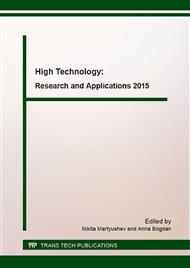[1]
N.M. Rusin, A.L. Skorentsev, The method for producing of wear resistant antifriction alloy, Patent RU 2492964. 20. 09. (2013).
Google Scholar
[2]
N.M. Rusin, A.L. Skorentsev, E.A. Kolubaev, Structure and Tribotechnical Properties of Al-Sn Alloys Prepared by the Method of Liquid-Phase Sintering, Advanced Materials Research. 1040 (2014) 166-170.
DOI: 10.4028/www.scientific.net/amr.1040.166
Google Scholar
[3]
N.M. Rusin, A.L. Skorentsev, Tribotechnical Properties of Sintered Aluminum Alloys, Applied Mechanics and Materials. 682 (2014) 9-13.
DOI: 10.4028/www.scientific.net/amm.682.9
Google Scholar
[4]
N.M. Rusin, A.L. Skorentsev, Improving the Tribological Properties of Self-Lubricating Al-Sn Alloys by their Severe Plastic Processing, Applied Mechanics and Materials. 379 (2013) 110-114.
DOI: 10.4028/www.scientific.net/amm.379.110
Google Scholar
[5]
V.M. Maltsev, T.A. Barsukova, F.A. Borin, Metallography of industrial non-ferrous metals and alloys, M.: Metallurgia, 1979. (in Russian).
Google Scholar
[6]
N.M. Rusin, A.L. Skorentsev, A.V. Gurskih, Strength of two-phase Al-Sn alloys subjected to equal channel angular extrusion, Izv. vuzov. Fizika. 9/3 (2014) 221-225. (in Russian).
Google Scholar
[7]
A.Z. Kashegev, Surface tension of liquid dilute alloys based on tin, indium, and wetting of copper and special steels by tin-silver and lead-bismuth eutectics, Avtoreferat dissertatsii kand. fiz. -mat. nauk, Nalchik, 2009. (in Russian).
Google Scholar
[8]
C. A. Drewien, F. G. Yost, S. Sackinger, J. Kern and M. W. Weiser, Progress Report: High Temperature Solder Alloys for Underhood Applications, SAND95-0196, (1995).
DOI: 10.2172/91947
Google Scholar
[9]
D. R. Frear, P. T. Vianco, Intermetallic growth and mechanical behavior of low and high melting temperature solder alloys, Metallurgical and Materials Transactions A. 25, 7 (1994) 1509-1523.
DOI: 10.1007/bf02665483
Google Scholar
[10]
S. D. Abdul-Ameer, S. Mohd, S. Mohd, B.I. Anjum, H.T. Guan, C.F. Xing, A.A. Naama, Microstructure and Tensile Properties of Sn-1Ag-0. 5Cu Solder Alloy Bearing Al for Electronics Applications, Journal of Electronic Materials. Vol. 41, Issue 8 (2012).
DOI: 10.1108/09540911211262548
Google Scholar
[11]
M. Aal, N. Mahallawy, F. Shehata and al., Tensile properties and fracture characteristics of ECAP-processed Al and Al-Cu alloys, Met. Mater. Int. Vol. 16, No. 5 (2010) 709-716.
DOI: 10.1007/s12540-010-1003-x
Google Scholar


